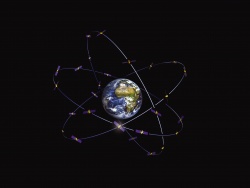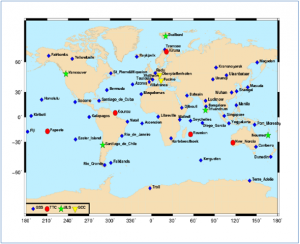If you wish to contribute or participate in the discussions about articles you are invited to contact the Editor
Galileo Architecture: Difference between revisions
No edit summary |
No edit summary |
||
| Line 21: | Line 21: | ||
* 5 TT&C stations. | * 5 TT&C stations. | ||
==GALILEO Space Segment== | ==[[GALILEO Space Segment]]== | ||
The main functions of the [[GALILEO Space Segment|Galileo Space Segment]] are to generate and transmit code and carrier phase signals with a specific [[GALILEO Signal Structure|Galileo signal structure]], and to store and retransmit the navigation message sent by the [[GALILEO Ground Segment|Control Segment]]. These transmissions are controlled by highly stable atomic clocks on board the satellites. | The main functions of the [[GALILEO Space Segment|Galileo Space Segment]] are to generate and transmit code and carrier phase signals with a specific [[GALILEO Signal Structure|Galileo signal structure]], and to store and retransmit the navigation message sent by the [[GALILEO Ground Segment|Control Segment]]. These transmissions are controlled by highly stable atomic clocks on board the satellites. | ||
| Line 30: | Line 30: | ||
Galileo will ensure Europe's independence in a sector that has become critical for its economy and the well-being of its citizens. | Galileo will ensure Europe's independence in a sector that has become critical for its economy and the well-being of its citizens. | ||
== | ==[[GALILEO Ground Segment]]== | ||
[[File:Galileo Ground Segment.png|300px|Galileo Ground Segment|right|thumb]]The [[GALILEO Ground Segment|Galileo Control Segment]] (also referred to as Ground Segment) is the responsible for the proper operation of the GNSS system. Its basic functions are: | |||
[[File:Galileo Ground Segment.png|300px|Galileo Ground Segment| | |||
* To control and maintain the status and configuration of the satellite constellation. | * To control and maintain the status and configuration of the satellite constellation. | ||
* To predict ephemeris and satellite clock evolution. | * To predict ephemeris and satellite clock evolution. | ||
| Line 48: | Line 39: | ||
The [[GALILEO Ground Segment|Galileo Ground Segment]] constitutes the major system element controlling the entire constellation, the navigation system facilities and the dissemination services. It is composed of two Ground Control Centres (GCC), five Telemetry, Tracking and Control (TT&C) stations, nine Mission Uplink Stations (ULS), and about fourteen Galileo Sensor Stations (GSS). | The [[GALILEO Ground Segment|Galileo Ground Segment]] constitutes the major system element controlling the entire constellation, the navigation system facilities and the dissemination services. It is composed of two Ground Control Centres (GCC), five Telemetry, Tracking and Control (TT&C) stations, nine Mission Uplink Stations (ULS), and about fourteen Galileo Sensor Stations (GSS). | ||
==[[GALILEO UserSegment]]== | |||
The [[GALILEO User Segment|Galileo user segment]] is composed by [[GALILEO Receivers|Galileo receivers]]. Their main function is to receive Galileo signals, determine pseudoranges (and other observables), and solve the navigation equations | The [[GALILEO User Segment|Galileo user segment]] is composed by [[GALILEO Receivers|Galileo receivers]]. Their main function is to receive Galileo signals, determine pseudoranges (and other observables), and solve the navigation equations | ||
Revision as of 08:45, 11 April 2011
| GALILEO | |
|---|---|
| Title | Galileo Architecture |
| Author(s) | GMV |
| Level | Basic |
| Year of Publication | 2011 |
The GALILEO System will comprise global, regional and local components. The global component is the core of the system, comprising the satellites and the required ground segment. To ensure GALILEO services, a specific architecture is deployed, that will consist of 30 satellites, to be deployed in a staggered approach, and the associated ground infrastructure.[1]
The Galileo system is divided into three major segments: Space Segment, Control Segment and User Segment.
Introduction
The Galileo full infrastructure will be composed of:
- A constellation of 30 satellites in Medium-Earth Orbit (MEO). Each satellite will contain a navigation payload and a search and rescue transponder;
- around 30 sensor stations;
- 2 control centres & 2 LEOP Centers;
- 9 Mission Uplink stations;
- 5 TT&C stations.
GALILEO Space Segment
The main functions of the Galileo Space Segment are to generate and transmit code and carrier phase signals with a specific Galileo signal structure, and to store and retransmit the navigation message sent by the Control Segment. These transmissions are controlled by highly stable atomic clocks on board the satellites.
When Galileo is fully operational, there will be 30 satellites in Medium Earth Orbit (MEO) at an altitude of 23,222 kilometres. The satellites will occupy each of three orbital planes inclined at an angle of 56° to the equator. The satellites will be spread evenly around each plane and will take about 14 hours to orbit the Earth. One satellite in each plane will be a spare; on stand-by should any operational satellite fail.
Based on the award of the contracts for the first order of satellites, the launch services, the system support services and the operations, the European Commission announced the Initial Operational Capability (IOC) with three initial services to be provided in 2014/2015: an initial Open Service, an initial Public Regulated Service and an initial Search and Rescue Service.[2] At this stage, accuracy and availability will not yet have reached their optimum level, the Safety-of-Life Service and the Commercial Service will be tested and will be provided as the system reaches full operational capability with the 30 satellites[3]
Galileo will ensure Europe's independence in a sector that has become critical for its economy and the well-being of its citizens.
GALILEO Ground Segment
The Galileo Control Segment (also referred to as Ground Segment) is the responsible for the proper operation of the GNSS system. Its basic functions are:
- To control and maintain the status and configuration of the satellite constellation.
- To predict ephemeris and satellite clock evolution.
- To keep the corresponding GNSS time scale (through atomic clocks).
- To update the navigation messages for all the satellites.
The Galileo Ground Segment constitutes the major system element controlling the entire constellation, the navigation system facilities and the dissemination services. It is composed of two Ground Control Centres (GCC), five Telemetry, Tracking and Control (TT&C) stations, nine Mission Uplink Stations (ULS), and about fourteen Galileo Sensor Stations (GSS).
GALILEO UserSegment
The Galileo user segment is composed by Galileo receivers. Their main function is to receive Galileo signals, determine pseudoranges (and other observables), and solve the navigation equations in order to obtain their coordinates and provide a very accurate time.
Notes
References
- ^ ESA Galileo web page
- ^ Commission awards major contracts to make Galileo operational early 2014, IP/10/7, Brussels, 7 January 2010.
- ^ Mid-term review of the European satellite radio navigation programmes



